The OnePlus 3 Review
by Brandon Chester on June 20, 2016 8:00 AM EST- Posted in
- Smartphones
- OnePlus
- OnePlus 3
System Performance
2015 was not a great year for Android devices. Snapdragon 810’s problems with throttling severely crippled the performance of high end smartphones. In the case of the OnePlus 2, OnePlus went even farther by putting in code that would detect when Google Chrome was in use and completely shut off the A57 cluster on the SoC. This resulted in web browsing performance that was essentially no better than what you’d find on a $100 phone shipping with Snapdragon 410, which simply wasn’t acceptable given the fact that the OnePlus 2 was priced at around $400.
Like most of this year’s flagship Android devices, the OnePlus 3 uses Qualcomm’s Snapdragon 820 SoC. We looked at Snapdragon 820 not long ago in the LG G5 review and saw that it provided a substantial improvement over Snapdragon 810, which became even greater when you consider prolonged workloads where Snapdragon 810’s A57 cores throttle down and shut off. Given that OnePlus no longer has any reason to put in strange app detection code to manage thermals, we should see a good uplift in general performance and an enormous improvement in web performance.
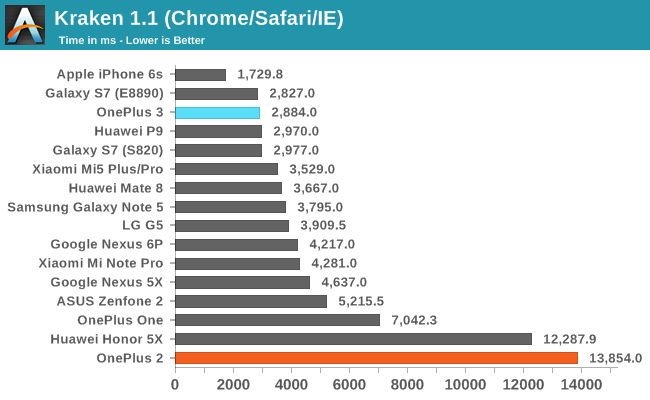
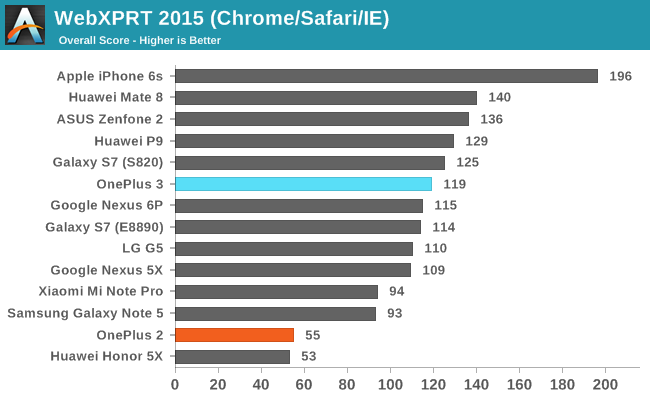
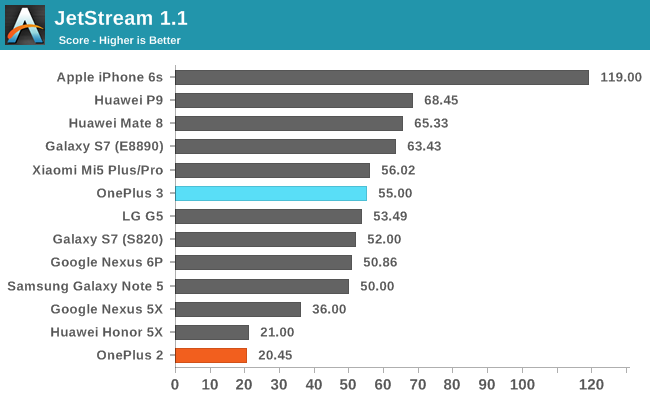
The improvement in web browsing performance when going from the OnePlus 2 to the OnePlus 3 is staggering. This isn't unexpected when you consider that the OnePlus 2 was just running on Cortex A53 cores that were meant for low power scenarios while the OnePlus 3 is using Qualcomm's Kryo cores. In Kraken the OnePlus 3 is over four times faster, while in WebXPRT and JetStream it's at least over two times faster. The OnePlus 2 actually represented a large regression in web performance compared to its predecessor, and OnePlus has brought web performance back to a level that is competitive with the other smartphones on the market with the OnePlus 3.

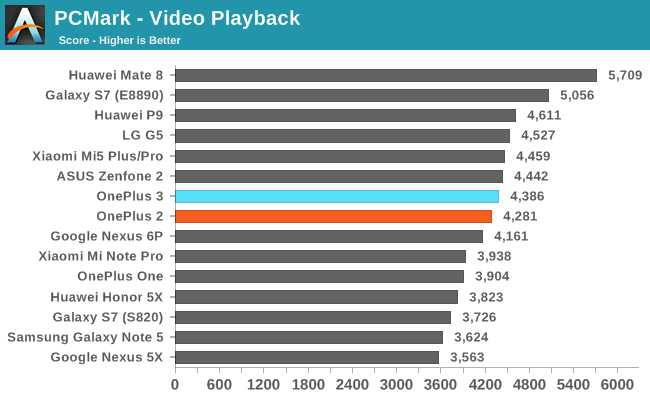

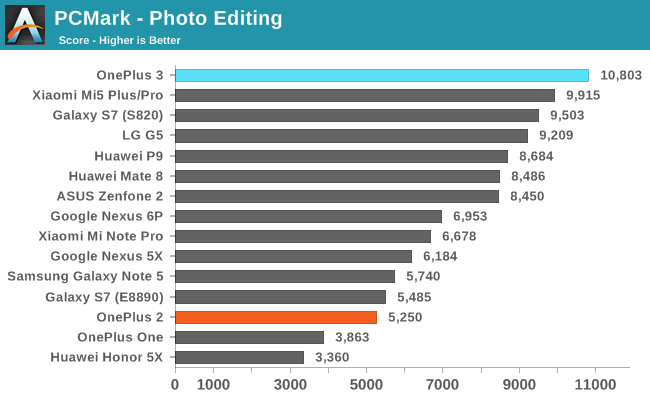
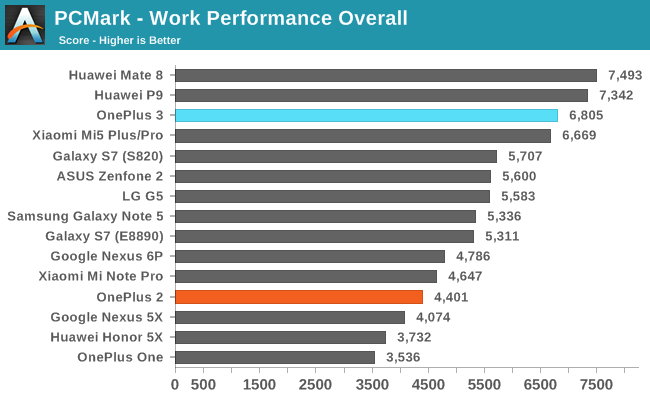
PCMark is an interesting test because it depends just as much on a phone's software as it does on the hardware. We've seen how devices with the same SoC can perform very differently, especially in certain sub-tests like the Writing and Photo Editing tests where different runtime and OS optimizations can have a large impact. The OnePlus 3 is no exception, with it achieving higher scores than the LG G5 in every test except for video playback where they have roughly the same scores.
This is not unexpected, as it was demonstrated in the LG G5 review that the G5 has more conservative frequency scaling than the other Snapdragon 820 devices that we've seen, which is reflected in PCMark's tests. In any case, the OnePlus 3 actually gets close to the Huawei Mate 8 in the writing test, and beats it and the LG G5 by a large margin in the photo editing test. In the end the OnePlus 3 places second on our overall chart, with only the Huawei Mate 8 ahead of it, and the gap between it and the Mate 8 being smaller than the gap between it and the Zenfone 2 which is the next fastest smartphone.
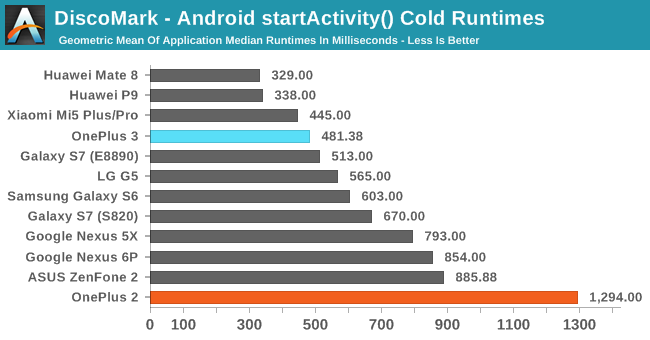
The OnePlus 3 is over two times faster than the OnePlus 2 with cold app launches where the application isn't resident in memory in any state. This is likely a combination of improved NAND performance, and changes to OnePlus's DVFS settings in addition to the performance improvements that Snapdragon 820 provides on its own. The impact that this has on the performance of the interface is significant, and when I reviewed the OnePlus 2 I noted how painfully slow it was to move around and through the applications. This new testing is a great example of that, with the OnePlus 2 taking 1.3 seconds just to launch apps, while the OnePlus 3 takes under 500ms and is the second fastest device here.
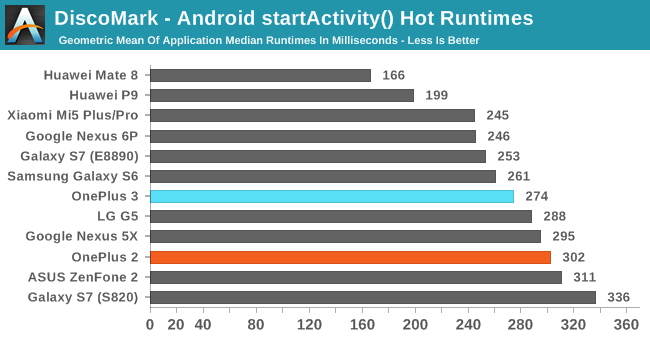
The OnePlus 3 improves a bit over the OnePlus 2 when resuming apps that are resident in memory, but not by a great deal. In general, all our devices hover between 250 and 300ms here, with the exception of the Huawei Mate 8 and P9 which are really in a category of their own for performance. While there's no enormous improvement here, the OnePlus 3 is competitive with other high end devices in the market, so there's nothing to complain about either.
One thing worth noting is that our set of apps wouldn't come close to utilizing the OnePlus 3's 6GB of RAM. Unfortunately, no matter how many apps we added, this would actually still be the case. The reason is that OnePlus has implemented very aggressive app eviction from memory, which means that your 6GB of RAM is really just sitting there using energy, and in general the utilization is pretty low. This may be a holdover from when the OnePlus 2 shipped in a 3GB configuration, but it's something OnePlus needs to address in a future OTA update. I'd imagine the Android enthusiast community is already at work on, or has already created custom kernels to alter this behavior as well. With 6GB of RAM you should be able to comfortably keep all of a user's frequently used apps resident in memory.
It's great to see that OnePlus is producing a smartphone with competitive performance once again. When the OnePlus One launched, Snapdragon 801 was the best you could get in an Android smartphone. The OnePlus 2 was an unfortunate victim of Snapdragon 810's heat and throttling problems, but OnePlus certainly didn't help the issue by hardcoding in mechanisms to detect Google Chrome and shut the A57 cluster off entirely. With the OnePlus 3 you get some of the best CPU performance in an Android phone, with PCMark's real-world tests demonstrating noticeable gains over the LG G5 which also uses Snapdragon 820. If I had to sum things up in a single line I'd just say that it's good to see that OnePlus is back in the game.


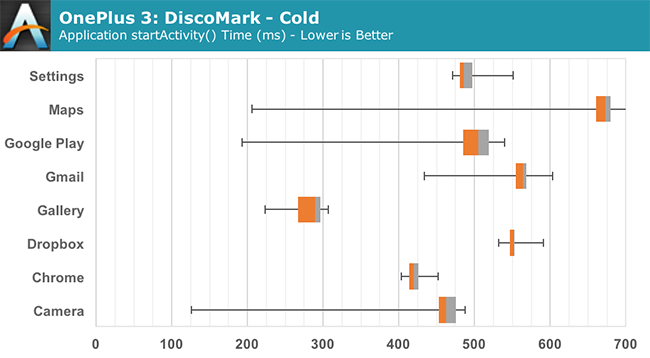
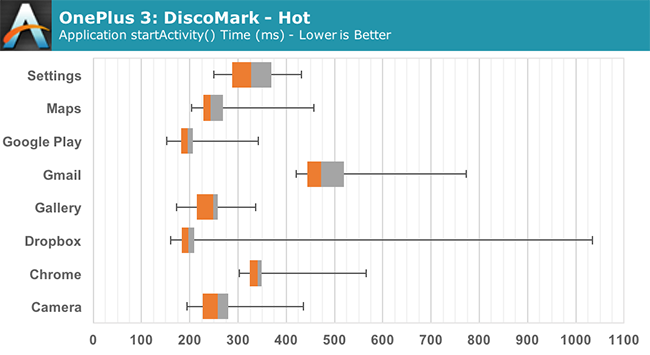








176 Comments
View All Comments
Ian Cutress - Monday, June 20, 2016 - link
We did some in the past, when Audio Precision let us borrow the $50k+ kit needed to do some proper testing. However, AP wanted the hardware back and Chris is no longer at AnandTech. If someone can convince AP to long-term loan us the hardware, I'm sure one of our smartphone team would pick up the mantle for the devices they test (and because the team is four people, it would only be tested on 1/4 of devices unless we get duplicates or can hand some off when people travel internationally for events. It also means you'd be lucky to see release day data, and we might have to do audio focused testing. But that all depends if we can get the hardware.)http://www.anandtech.com/show/8078/smartphone-audi...
dishayu - Monday, June 20, 2016 - link
Thanks for the response. Yeah, sounds like a challenge and a half. I am aware of the past audio testing, which is why I was hoping for more. Maybe a more practical approach would be to send one person to a partnered lab and run a gauntlet test on all phones released in that year... like a shootout, maybe.cheinonen - Tuesday, June 21, 2016 - link
Yeah, I'm no longer here but the equipment made to do that level of audio testing is incredibly expensive. I live down the street from Audio Precision so I could borrow it, but most people testing audio quality are using gear with noise levels that are high enough that you can't trust the testing unfortunately.Spectrophobic - Monday, June 20, 2016 - link
That... is one disgusting screen.Google please refresh the 5X with an 820 and UFS 2.0.
tipoo - Monday, June 20, 2016 - link
So provide 6GB RAM, then make the software aggressively cull its use to save energy?Apart from future proofing (and to be real, it'll probably run out of Android updates well before 3/4GB would be a limit), that seems rather pointless.
I'd hope like the author hopes that an over the air update would address that, but if the founder said it was to save energy, maybe it's just an intentional choice they'll keep around until 6GB makes any sort of sense in a phone (which again, is probably outside of the usable life of this one).
That said, I think they're generally back on track which is nice. The Oneplus One was a hit, the Two was a miss, this seems closer to the One competitively.
tipoo - Monday, June 20, 2016 - link
So 10 months after launch, much closer to the launch of the 7 now than the 6S, the NVMe storage solution is still pooping all over everyone elses, huh? The OP3 is the closest to bridging the gap on reads, but still a whole 128MB/s behind, and much further in writes (which are cool particularly for app installs - I barely see the install icon anymore after the download).I'm curious, is it *because* of NVMe? It doesn't seem like it should be, I mean NVMe is awesome but mainly reduces the AHCI latencies and gives a stupid amount of in flight queues that consumers probably don't approach often. Is it just how many channels Apple gives their NAND? Is there a limit to how much UFS 2.0 can scale up?
All this said, on the flip side, NVMe seems to take a hit in 4KB random reads/writes, with Samsungs controller overtaking the 6S there, among some others.
tipoo - Monday, June 20, 2016 - link
Hm, I see the author also suggests it's because the 6S was the 128GB model. I guess I had assumed they'd all perform the same, despite always knowing larger SSDs usually do better due to more channels.Now I want to test a 16GB 6S to see how the storage fares. What test is used?
Pissedoffyouth - Monday, June 20, 2016 - link
Random read and write matters much more than sequential, expect for heavy burst photography which the 6GB RAM should help withtipoo - Monday, June 20, 2016 - link
I recall some of the early generations of SSDs had 4K random read/write performance as a culprit for why they would freeze up for a second in worst case situations on a PC, and increasing the random performance was found to be an important metric back then as much as if not more than sequential transfers.However I do wonder at what point of 4K random read/write performance increases is where it will no longer provide any extra kick to most consumer workloads, while hopefully the OS is writing app binaries in nice sequential rows for app launch reads. Going down to 4KB reads would still very much be a very worst case scenario.
thek - Monday, June 20, 2016 - link
I feel like the reviewer reviewed this device as on-par with other premium/flagship devices that literally cost twice as much and not take into account the device's cost. And I'm not talking about just mentioning the cost itself here.The question should be if devices that cost less(and we're really talking about 1/2 the price of any flagship, with literally the same hardware) should be reviewed differently. Now, by differently I don't mean with different or lower standards ,but maybe with the knowledge that this device is clearly cheaper than other flagships devices for a reason. Something had to be cut back.
If the display was premium as well, that device wouldn't been able to get to a 399$ price mark and make a profit (only makes sense). So if it's not reaaally crucial I'd say it's a slight issue but not one to make you not purchase the phone.
Basically I'm just saying all of this because the last 3 paragraphs really dished the device into making it seem like a no-buy right now to anyone that doesn't want to suffer from a really bad display (again, this is how it sounds to a non-technical guy that just wants a smartphone). Furthermore, as you mentioned, you are a pro reviewer and have different standards, that maybe do not imply to regular users? Yes, you've mentioned it(very slightly), but saying something like you won't replace your old low end phone for this one just because of the display makes it sound probably worse than it is(or actually, the worse it can be: ''but for anyone who cares even the slightest bit the issues with the OnePlus 3’s display will be too severe to live with.''). I'd recommend providing the device for some day to day users/family members and asking if they enjoy the display.
With all of that said, I think that companies that are trying to do things differently for the better or to be cheap on the consumers expense (like Samsung, Apple, and basically any other that charges double the amount for the same hardware or charges premium prices every year for the same old battery's and storage- which Xiaomi showed us with the Redmi note 3 pro that a 4000 battery is possible with a 200$ or less phone) should be praised.
Only god knows why reviewers provide each year an A grade score for the Galaxy's and Iphone's when they don't even provide bigger batteries which is clearly out of making us buy their next phones again next year.
I'd bash them, and not OP or Xiaomi for trying to provide more for less. just my 2 cents